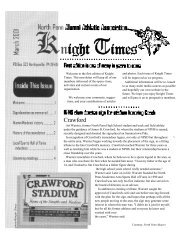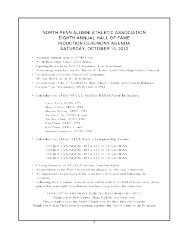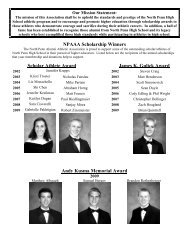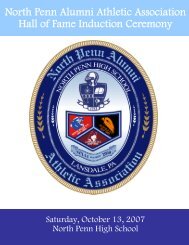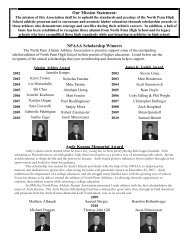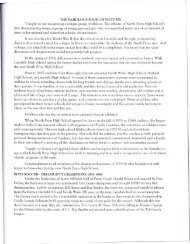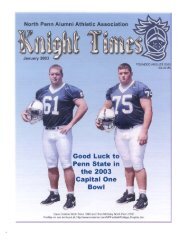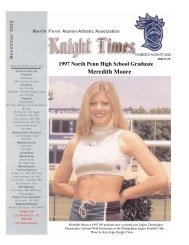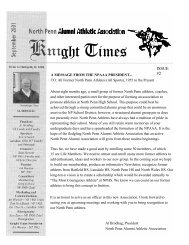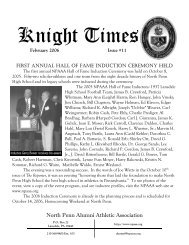2008 NPAAA Hall of Fame Inductees - North Penn Alumni Athletic ...
2008 NPAAA Hall of Fame Inductees - North Penn Alumni Athletic ...
2008 NPAAA Hall of Fame Inductees - North Penn Alumni Athletic ...
You also want an ePaper? Increase the reach of your titles
YUMPU automatically turns print PDFs into web optimized ePapers that Google loves.
A History <strong>of</strong> the <strong>North</strong> <strong>Penn</strong> School System<br />
Dick Shearer<br />
The roots <strong>of</strong> public education in the <strong>North</strong> <strong>Penn</strong> area predate the Civil War when simple one-room schoolhouses<br />
dotted the countryside. They <strong>of</strong>fered schooling at the most basic level because all the primary grades were taught<br />
by a single teacher in that one-room environment. Students who wanted “higher” education had to travel to a<br />
town where advanced courses were available. As villages grew into larger boroughs in the 1880s, 12-year diploma<br />
programs were <strong>of</strong>fered in these schools, and senior classes evolved – some with as few as a single student.<br />
Lansdale School District was formed in 1871, a year before the community became an incorporated borough. In<br />
1872, its first public school was built on East Main Street, where Citizens Bank now stands. The first graduating<br />
class in 1888 consisted <strong>of</strong> four students. The original school on Main Street was replaced by the larger Broad<br />
Street and Green Street schools in 1888 and 1899, respectively, but it was not until 1914 that the first Lansdale<br />
High School was built on the site <strong>of</strong> the present McDonald’s restaurant.<br />
An influx <strong>of</strong> new industries and affordable residential housing quickly pushed the high school building past<br />
capacity, and in 1930, the school board agreed to build a new high school on <strong>Penn</strong> Street, where there would be<br />
plenty <strong>of</strong> room for future expansion. Because <strong>of</strong> this foresight, the second Lansdale High School stood the test <strong>of</strong><br />
time much better than its predecessor. Over a period <strong>of</strong> 40 years, the campus grew to serve a total <strong>of</strong> seven towns<br />
and townships in the region.<br />
When regional consolidation took place in 1955, the <strong>Penn</strong> Street school underwent a massive expansion project<br />
that more than doubled the size <strong>of</strong> the original school. In June 1955, the final Lansdale High School diplomas<br />
were awarded, and three months later <strong>North</strong> <strong>Penn</strong> High School was born.<br />
Like Lansdale, Hatfield’s education system evolved from one-room schools into a larger school that began <strong>of</strong>fering<br />
advanced grades during the 1890s. Hatfield Consolidated School District was formed in 1921 when residents <strong>of</strong><br />
the borough and township agreed to erect a modern high school on the borough-township line in 1921. The new<br />
facility contained 19 rooms and was built on a 10 1/2-acre tract at Fairgrounds and Cowpath Roads. When the<br />
building opened in September, 1922, it was the first six-year high school in this part <strong>of</strong> the state. A total <strong>of</strong> 492<br />
students were brought together under the same ro<strong>of</strong>, taught by a 15-member faculty. Hatfield High featured the<br />
largest auditorium and gymnasium between Philadelphia and the Lehigh Valley. Now the home <strong>of</strong> the Biblical<br />
Theological Seminary, Hatfield High School’s last graduates received their diplomas in 1955. The high school<br />
closed its doors on June 10, 1955, and in September, 1955, Hatfield’s underclassmen began attending the <strong>North</strong><br />
<strong>Penn</strong> Joint High School in Lansdale.<br />
Public education in <strong>North</strong> Wales also began with a one-room school located on Main Street that was built before<br />
the town was incorporated in 1869. The bustling young town soon outgrew its first schoolhouse and a new one<br />
was erected at Third and School Streets. By the 1890s that structure also proved inadequate and a three-story<br />
addition was built to house all 12 grades. <strong>North</strong> Wales held its first commencement in 1887 – with one student<br />
receiving a diploma. The School Street building was replaced in 1928 by what is now <strong>North</strong> Wales Elementary<br />
School on Summit Street. Like Lansdale and Hatfield, <strong>North</strong> Wales became a part <strong>of</strong> the <strong>North</strong> <strong>Penn</strong> Jointure in<br />
1955, ending the era <strong>of</strong> independent school districts – and high schools – in each town.<br />
To come full circle, the post-World War II construction boom impacted the once rural townships <strong>of</strong> Hatfield,<br />
Montgomery, Upper Gwynedd and Towamencin much like the rapid growth the boroughs experienced a halfcentury<br />
earlier. The venerable Lansdale/<strong>North</strong> <strong>Penn</strong> High School was no longer able to contain the influx <strong>of</strong> new<br />
students. In 1971 a new, massive high school campus was built in Towamencin, and <strong>Penn</strong> Street was converted<br />
into what is now <strong>Penn</strong>dale Middle School.



